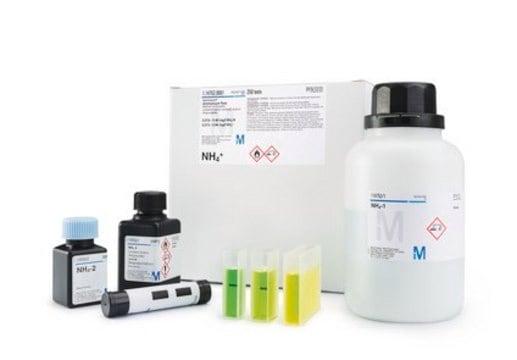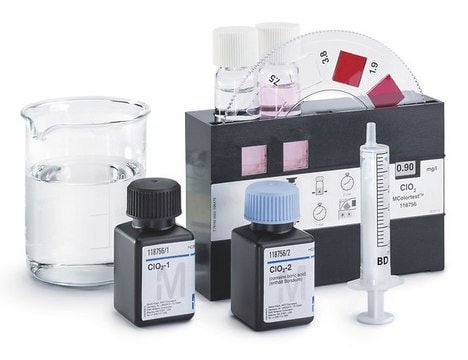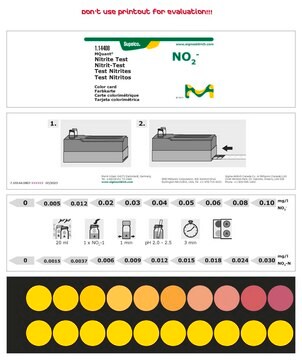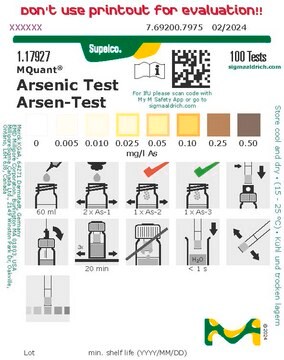1.18754
Chlorine Dioxide Test Kit, colorimetric
0.020-0.55 mg/L (ClO₂), MQuant®
Sinónimos:
Chlorine Dioxide Visual Test Kit
About This Item
Productos recomendados
product name
Chlorine Dioxide Test, colorimetric, 0.020-0.55 mg/L (ClO2), for use with MCOLORTEST®
product line
MColortest®
Quality Level
specific analyte(s)
chlorine dioxide
measuring range
0.020-0.55 mg/L (ClO2)
compatibility
for use with MCOLORTEST®
detection method
colorimetric
storage temp.
15-25°C
General description
Method
In weakly acidic solution chlorine dioxide reacts with dipropyl-p-phenylenediamine (DPD) to form a red-violet dye. The chlorine dioxide concentration is measured semiquantitatively by visual comparison of the color of the measurement solution with the color fields of a color card.The unique brilliance of the print and their fine color graduation allow precise analyses, even at the lower end of the concentration range. Due to the long test tubes a sensitive measurement range can be covered.
Using the refill pack 1.18757 containing all the reagents, the original test kit can be used for a very long time, making it a particularly economical and ecological system.
This test can be used for
- Drinking water
- Disinfectant solutions
- Boiler and boiler feed water, cooling water
This test is not suited for seawater.
Application
- Water Treatment and Disinfection: Chlorine dioxide is extensively used in water treatment for its effectiveness in disinfecting drinking water and wastewater. It is an efficient biocide that helps control biofilms and eliminates pathogens. Recent studies focus on the oxidation of natural organic matter in water treatment plants, evaluating the effectiveness of ClO2 in removing contaminants and its impact on water quality and environmental safety (Özdemir, Environment Protection Engineering, 2020).
- Environmental Monitoring: Chlorine dioxide testing is essential for environmental monitoring to ensure that disinfection by-products (DBPs) do not pose a risk to human health or the environment. Research has highlighted the importance of monitoring ClO2 levels and its by-products in various ecosystems to prevent adverse ecological impacts (Kinani et al., Critical Reviews in Analytical Chemistry, 2022).
- Food Safety and Sanitation: ClO2 is used in the food industry for sanitizing equipment and surfaces, as well as for washing fruits and vegetables. It is effective in reducing microbial contamination and extending the shelf life of food products. Analytical methods for detecting ClO2 residues in food items are critical for ensuring consumer safety and compliance with regulatory standards (Fabbricino et al., Chemosphere, 2019).
- Chromatographic and Mass Spectrometric Analysis: Advanced analytical techniques such as chromatography and mass spectrometry are employed to study the speciation and degradation products of chlorine dioxide. These methodologies are crucial for understanding the chemical behavior of ClO2 in different matrices and for developing accurate detection methods (Roumiguières et al., Critical Reviews in Analytical Chemistry, 2023).
- Cyclic Voltammetry for ClO2 Detection: Cyclic voltammetry is used for the precise determination of free chlorine and chlorine dioxide levels in various water samples, including seawater aquariums. This electrochemical method provides high sensitivity and specificity, making it suitable for monitoring ClO2 in complex aqueous environments (Ko et al., Chinese Journal of Analytical Chemistry, 2022).
Legal Information
signalword
Danger
hcodes
Hazard Classifications
Eye Irrit. 2 - Repr. 1B
Storage Class
6.1C - Combustible, acute toxic Cat.3 / toxic compounds or compounds which causing chronic effects
wgk_germany
WGK 2
Certificados de análisis (COA)
Busque Certificados de análisis (COA) introduciendo el número de lote del producto. Los números de lote se encuentran en la etiqueta del producto después de las palabras «Lot» o «Batch»
¿Ya tiene este producto?
Encuentre la documentación para los productos que ha comprado recientemente en la Biblioteca de documentos.
Protocolos
Preparation of a standard solution for Chlorine dioxide acc. to DIN EN ISO 7393
Nuestro equipo de científicos tiene experiencia en todas las áreas de investigación: Ciencias de la vida, Ciencia de los materiales, Síntesis química, Cromatografía, Analítica y muchas otras.
Póngase en contacto con el Servicio técnico









